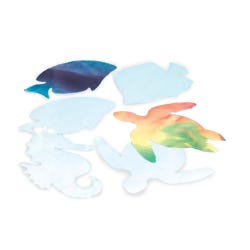Hawaiian Tapa Cloth Paintings

Description
Native bark paintings, called Tapa cloth were traditionally used as clothing in Pacific Island cultures. The inks used were traditionally made from ash and ground nuts. Through this project, students can identify patterns, shapes, compositional features such as borders, asymmetry and symmetry, plant and animal motifs.
Objectives
- After looking at Tapa cloths, have students create original sketches combining a patterned border and a central motif of an animal or plant. As an option, students can use Hawaiian animals and plants or use animals and plants native to their own local geography.
- Use Roylco®s Color Diffusing Die Cuts - Sea Life that includes turtle, seahorse and fish shapes, as a visual tool to help students find inspiration.
Supplies Needed
Egyptian Papyrus Pape 40256705
Banana Papers 404994
Sax® Extra Heavy Manila Paper 9"x12" 08557705
Reeves Water Soluble Wax Pastels, 12-Color Set 1289938
Derwent Inktense Pencil Set, 12-Color Set 409264
Derwent Non-Toxic Tinted Charcoal Pencil, Assorted Color, Pack of 6 1299455
Reeves 12-Pan Watercolor Set 405897
Reeves Watercolor Pencils, 12-Color Set 404697
Derwent Coloursoft Pencils 410418
Krylon® Crystal Clear 416155
Derwent Highly Pigmented Non-Toxic Water Soluble Watercolor Pencil Set, Assorted Color, Set of 24 407202
School Specialty Flat Assorted Trim Plastic Handle Art and Craft Brush Set, Assorted Size, Set of 144 449951
Roylco® Diffusing Die Cut - Sea Life 40762705
You could also use these papers:
Brown Kraft Paper - rolls or sheets
Unryu Paper Assortment
Sax® Construction Paper
Sax® Gray Drawing Paper
Bogus paper
Standards
CONTENT Standard #1: Understanding and applying media, techniques and processes.
CONTENT Standard #4: Understanding the visual arts in relation to history and cultures.
CONTENT Standard #6: Making connections between visual arts and other disciplines.
Instructions
1
Using a natural paper or any paper that resembles bark texture and color, students will create their Tapa cloth. You may use a variety of inks, watercolors, pencils and markers. Traditionally, natural earth tone colors were used to create the designs but some modern Tapa cloth paintings now feature bright colors. Banana Papers: The Banana paper comes in assorted colors and has a natural look and feel with visible fibers. The paper is soft and thin and does not require a lot of water when using wet media. Place a light wash over the area to be painted. You can affix the paper directly to the table with the wash of water. This will help keep the paper in place. Using the Derwent Inktense water soluble pencils, draw directly on the wet surface. The color will feel like smooth ink bleeding into the wet surface. Inktense pencils glide on smooth on a wet surface and the colors are vibrant. Using Reeves water soluble wax pastels draw the image first then add water with a brush to smooth the color and create a painted look. Egyptian Papyrus Papers: These are the most authentic papers to a traditional Tapa bark painting. The papyrus papers come in assorted natural colors and textures with visible fibers and larger pieces of bark. These papers are stiff and have a slight slick feel. They do not hold a lot of water but they are durable. Using Inktense pencils or water soluble wax pastels you may draw onto the paper dry or wet and use a paintbrush to smooth out the color and define shapes and edges. Sax® Manila Drawing Paper 80 lb. Extra Heavy: This paper is durable with a soft feel. The extra heavy manila paper will stand up to a heavier hand when applying wet media. This paper will accept either application of wet or dry media described above and is great for mixed media applications.
2
Leave a deckled edge or torn edge along all sides of the painting and mount on a contrasting paper or board for display. You may also wish to spray paintings with a clear coat of varnish or coat with Sax® watercolor varnish for protection.
3
Try Derwent soft drawing pencils or Derwent Coloursoft drawing pencils for students with special needs. These soft pencils are vibrant and creamy smooth to apply without any mess of using water for students with severe sensory needs. Reeves and Derwent water soluble pencils are also great alternatives for students with less severe sensory needs, allowing all students to be successful.




